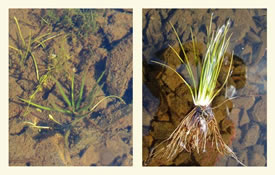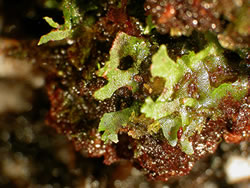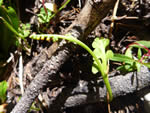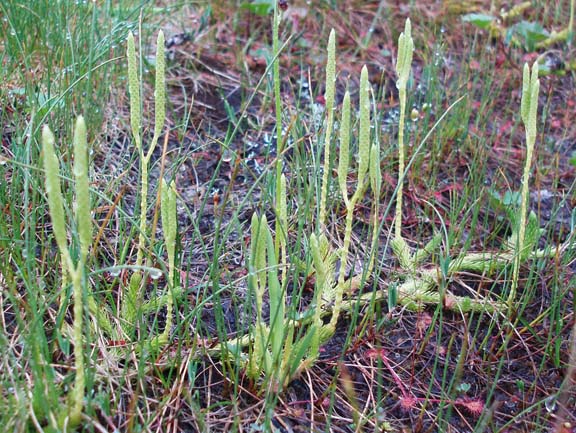What Are Ferns?
Ferns are plants that do not have flowers. Ferns generally reproduce by producing spores. Similar to flowering plants, ferns have roots, stems and leaves. However, unlike flowering plants, ferns do not have flowers or seeds; instead, they usually reproduce sexually by tiny spores or sometimes can reproduce vegetatively, as exemplified by the walking fern.
In the past, ferns had been loosely grouped with other spore-bearing vascular plants, often called “fern allies”. Recent genetic studies reveal surprises about the relationships among ferns and fern allies. First, ferns appear to be closely related to the horsetails. In fact, horsetails are now grouped as ferns. Second, plants commonly called “fern allies”, club-mosses and quillworts, are not at all related to the ferns. General relationships among members of the plant kingdom are shown in the diagram below.
 Walking fern (Asplenium rhizophyllum) growing on a mossy rock face in eastern Tennessee. This fern can reproduce vegetatively. Note the little fernlets growing at the tips of the elongated fern fronds. Photo by Kris Light.
Walking fern (Asplenium rhizophyllum) growing on a mossy rock face in eastern Tennessee. This fern can reproduce vegetatively. Note the little fernlets growing at the tips of the elongated fern fronds. Photo by Kris Light.
 A cladogram showing the general relationships among members of the plant kingdom.
A cladogram showing the general relationships among members of the plant kingdom.
Quillworts
 Western quillwort, Isoetes occidentalis, growing in a shallow lake on Prince of Wales Island, Alaska, Tongass National Forest.
Western quillwort, Isoetes occidentalis, growing in a shallow lake on Prince of Wales Island, Alaska, Tongass National Forest.
Quillworts are the only descendents of trees that dominated the swampy forests during the Coal Age, about 320 million years ago. Quillworts are small plants that generally grow in shallow water. About 25 species grow in North America.
The western quillwort image shows the plant rooted in the mud at the bottom of a shallow lake (left). Note the simple quill-like leaves emerging from the mud.
This image also shows the entire plant floating on the surface of the lake (right). The bases of the leaves are pale because they were buried in the mud and did not receive sunlight.
Fern Success Stories
The Big Search for Tiny Ferns
 Hymenophyllum wrightii gametophytes growing in a tangled clump on rotting wood. Photo by Aaron Duffy.
Hymenophyllum wrightii gametophytes growing in a tangled clump on rotting wood. Photo by Aaron Duffy.
For many years, Forest Service botanists have been interested in finding an elusive plant called Wright’s filmy fern (Hymenophyllum wrightii) in the Alaska Region. The fern was designated by the Regional Forester as an Alaska Region Sensitive Species in 1994 because of its apparent rarity. However, interest in the plant began several decades earlier.
Read more about the big search for tiny ferns…
Botrychium Treasure Hunts - November 2011

On August 6 and August 20, 2011, members of the Nevada Native Plant Society visited two spring sites in the Spring Mountains, Clark County, Nevada, to search for and, hopefully, learn how to identify Botrychium species. Botrychiums, also known as moonworts, belong to the Ophioglossaceae, an ancient family of plants distantly related to modern ferns.



